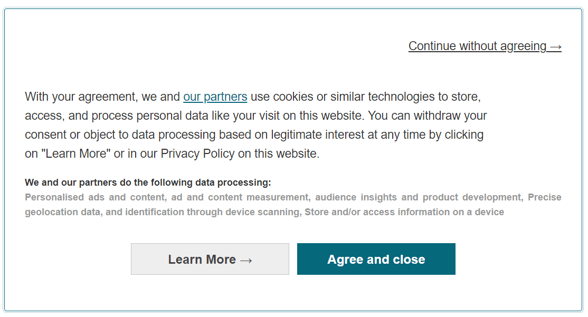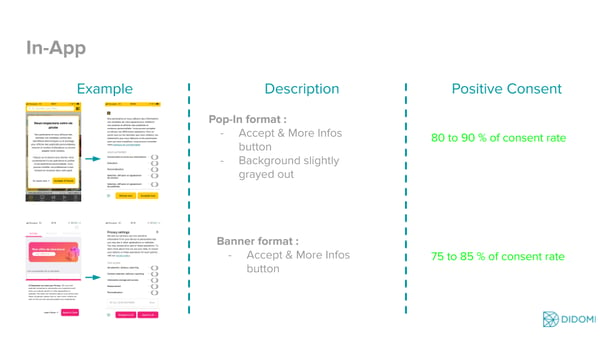📕 First of all, a quick explanation of how we calculate and produce the statistics in this document.
What is considered as consent?
We consider as consent a user who has accepted, at least, one of the purposes or one of the vendors displayed. If a user does nothing on your website, we consider that he didn't consent.
How is the consent rate calculated?
Number of pages viewed with consent / Overall number of pages viewed (with & without consent) *100
How is the average consent rate determined?
📊 We use a method that calculates average consent through weighted averages based on the number of pages visited.
The document is split into 3 distinct parts. The first one includes the various statistics established on the so-called "Desktop" environment, the second one presents the different types & way of collecting consents through the top 100 French publishers according to ACPM figures. Note that these statistics are only produced on "Desktop". The third part will include the different statistics produced from the "In-App" environment.
On pop-in formats
- Didomi customers using a Consent Management Platform with a Pop-In format collect between 90% & 95% of consent rate with no "Refuse"/equivalent button.
- On pop-in consent notices with the "Refuse" button/equivalent, the consent rate is between 70% and 80%.
- On web pop-in banners, the link "Continue without agreeing" enables to generate between 70% and 85% of consent rate. Same format banners with a "Refuse" button offer between 60% and 75% of consent rate.
- With an identical negative option on the pop-in and sticky banner formats, the pop-in format increases the positive consent by 5% to 15% compared to the other one.
⚠️ These numbers are averages from April/May 2021 and may change with time. We will make sure to keep them up to date when we get some new data.
🍪 Feel free to check out our article about the Legal specificities on cookie consent in some european countries that will let you see where the "Refuse" & "Agree" buttons are mandatory.
On sticky-banner formats
- Didomi customers who are using a CMP with the Pop-in Format without any "Refuse" button/equivalent button, get between 90% and 95% of consent rate.
- The banner format top/bottom allows to collect a consent rate of 75 to 90% with no "Refuse"/equivalent button.
- On sticky-banner consent notices that display the "Refuse" button, the consent rate is between 60% and 75%.
- The sticky banner format enables to collect between 65% and 70% of consent.
All mixed formats, we can observe that having a different color on the "Agree" and "Disagree" (or equivalents) buttons increases consent rate by 3%.
⚠️ These numbers are averages from April/May 2021 and may change with time. We will make sure to keep them up to date when we get some new data.
Follow the steps in the 📰 technical documentation to add the "Continue without agreeing" link and see the options possible with the "Disagree" button.

Note that the first page the user lands on is considered as viewed “without consent” in the statistics we build our article with (sticky banner). When a user first visits a website, he is not deemed to have consented and therefore no targeted advertising should be displayed. This calculation method allows to better reach your advertising revenues.
⚠️ Be careful, the consent rate depends on the method you collect consent (scroll, navigation click). We do not recommend using the “scroll method” to collect the user consent because the French Data Protection Authority (CNIL) does not consider this method as a valid consent.

.png?width=600&name=downloads.intercomcdn.comio1565551279435a58e11d07ec4b9fe008aCMP+format+comparison+(1).png)
Through the In-App Environment, we observe that:
- The Pop-In format allows to collect between 80% & 90% of consent rate.
- The Banner format allows to collect a consent rate of 75% to 85%.
- The format displaying all the purposes on the first page allows to collect between 65% & 75% of consent rate.
✍️ Checklist of ways to improve your consent rate
✅ A title on your consent notice such as "Privacy is our priority"
✅ Grouping purposes in categories is user-friendly as it eases granular choices✅ Create your own purposes: customized advertising, non-customized advertising, geolocalized advertising... (recommendations from the CNIL, the French DPA)
✅ Personalized and easy-implementing cookie wall with the Poool & Didomi integration on web platforms only: the user either gives his consent for cookies or accepts another alternative (subscription, creation of an account...). This offers you better consent rates and monetization. Please, check out this article that explains whether or not, cookie walls are legal in different countries and this other documentation about How to set up a cookie wall with the Poool integration. Cookies walls allow you to obtain consent rates of more than 85%!
✅ Another functionality we offer is the cross-device consent to share consent on different websites and apps, whether it is on the same or different devices. This improves your monetization and your consent rate as you don't ask consent multiple times to the user (user friendly).
✅ Our batch export gives you access to the consent choices of users on a daily-basis: consent status, the previous status' records and the users' proof of consent. Feel free to read this article about how we manage the proof of consent!